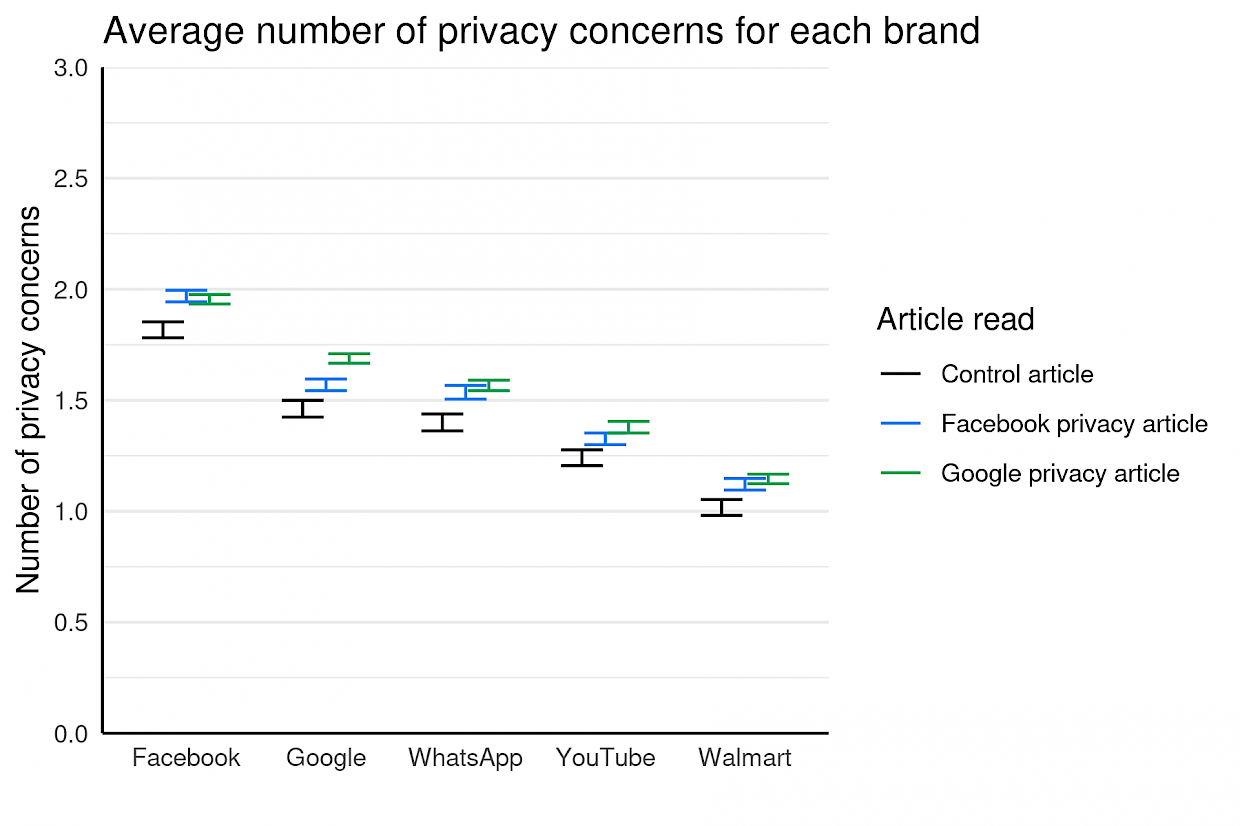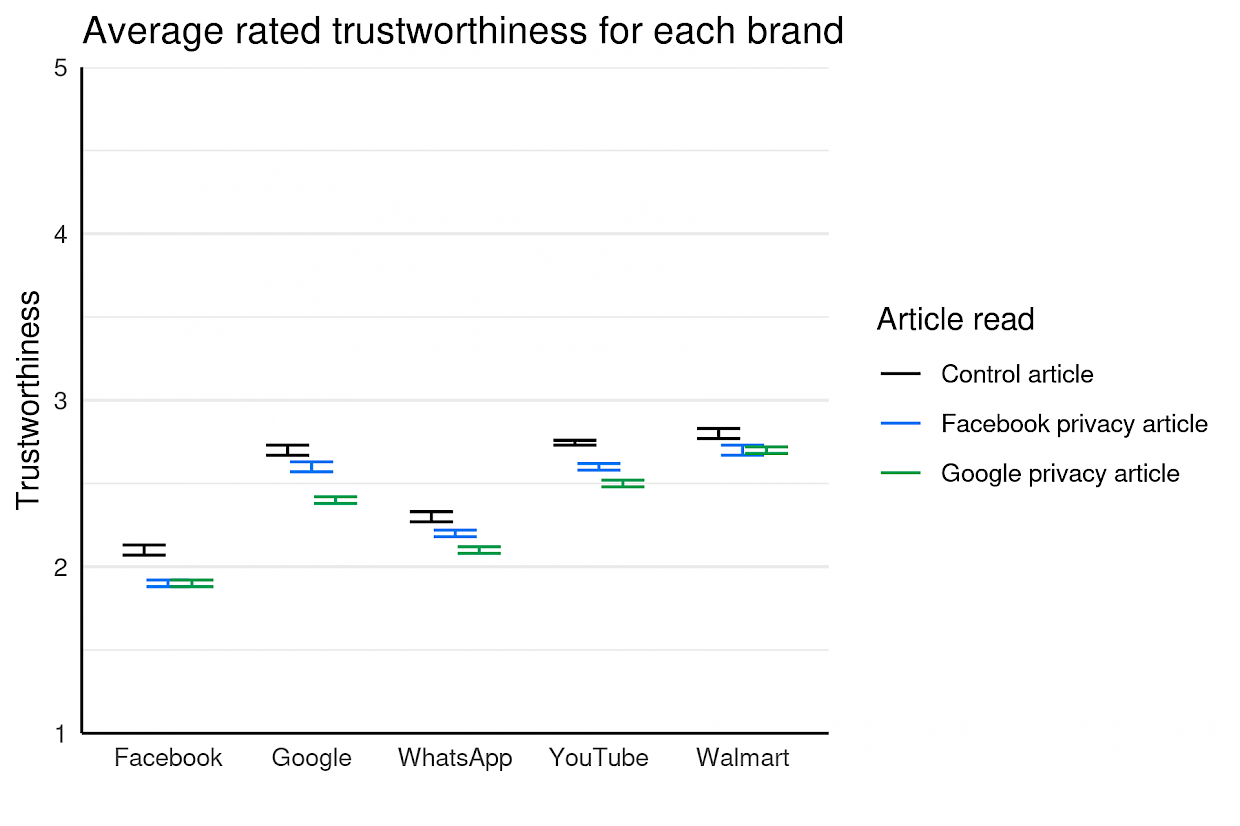Publication date: 12/15/2021
Authors’ note: Product teams at Meta rely on research along with other external factors to design and build products. This article discusses research conducted by Meta’s Privacy Research Team to better understand people's privacy beliefs.
Abstract
We hypothesized that when someone reads a news article about the privacy practices of one app, it might “spillover” and impact how they think about other, unrelated apps.
To test this, we randomly assigned research participants to read a news article that (a) was critical of Facebook’s privacy practices, (b) was critical of Google’s privacy practices, or (c) discussed Facebook or Google but did not discuss privacy practices.
When participants read a news article that was critical about Facebook or Google’s privacy practices, they reported more privacy concerns and lower brand trust for all brands we asked about, including brands that weren’t mentioned in the article. This is evidence for a spillover effect in response to privacy news articles.
Report
This research was motivated by a simple but intriguing question:
When someone reads a news article about the privacy practices of one app, does their reaction “spillover” and impact how they think about other, unrelated apps?
We were inspired to ask this question based on two past research insights.
Past insight #1: The spillover effect in psychology. In psychology, the spillover effect is when information changes someone’s beliefs about something that wasn’t contained in the information itself. For example, reading an article about the shock absorption for a running shoe can impact consumers’ perceptions for other attributes of the shoe such as how technologically innovative it is (Ahluwalia, Unnava, & Burnkrant, 2001). The spillover effect occurs in part because people sometimes believe certain attributes are related, so learning about one attribute can make people feel comfortable making assumptions about other attributes. In the running shoe example, technological innovation could impact shock absorption, so learning that the shoe has good shock absorption can lead some people to assume it might also be technologically innovative.
Past insight #2: Privacy concerns for different apps tend to be related. Our past research has shown that people’s privacy concerns about different apps tend to be related (Hepler & Rutherford, 2021). For example, people who are concerned about data collection on Facebook also tend to be concerned about data collection on any other given app (e.g., Google, Snapchat, Twitter). Privacy concerns for different apps can be related for a few reasons. First, people sometimes rely on a general understanding of technology when forming beliefs about specific apps - e.g., assuming that most apps use similar technologies or policies. Second, people may sometimes intentionally generalize their beliefs about one app to other apps as a functional strategy. For example, rather than investing time and effort to learn about the data policies for every single app someone uses, it can be easier and take less time to simply assume that any given app might engage in some data practice if one app does it.
Thinking about these past insights together led us to hypothesize there might be a spillover effect for information about privacy. That is, because people are prone to assuming that different apps have similar privacy practices, when people read privacy information about one app, they may assume the information could apply to other apps as well. This could result in new privacy information about one app impacting people’s privacy beliefs or brand perceptions for other, unrelated apps. We were particularly interested in this idea in relation to news articles about privacy because the news is a common source of privacy information for the general public.
To test this hypothesis, we conducted a survey experiment in which we randomly assigned 22,443 survey participants to read one of three types of news articles: (a) A news article that was critical of Facebook’s privacy practices, (b) a news article that was critical of Google’s privacy practices, or (c) a news article that discussed Facebook or Google but did not discuss privacy practices. After reading the article, participants reported their brand trust and specific privacy concerns for a range of apps and companies that have popular digital experiences: Facebook, Google, WhatsApp, YouTube, and Walmart. For additional method details including the news articles we used for the study and more information about the survey sample, see the Appendix below.
Expected results if there is a spillover effect: If there is a spillover effect for privacy news, then participants who read the Facebook or Google privacy news articles should report more privacy concerns and lower trust for all brands in the study (Facebook, Google, WhatsApp, YouTube, and Walmart) relative to participants who read the news articles that didn’t discuss privacy.
Expected results if there is no spillover effect: In contrast, if there is no spillover effect then reading the Facebook privacy news articles should only increase privacy concerns and decrease trust for Facebook but not the other brands. Similarly, reading the Google privacy news articles should only increase privacy concerns and decrease trust for Google but not the other brands.
As it turned out, the results showed evidence for a spillover effect of privacy news. As can be seen below in Figures 1 and 2, when participants read a privacy news article that was critical about Facebook or Google, not only did it increase privacy concerns and decrease brand trust for the brand that was discussed in the article, it also increased privacy concerns and decreased brand trust for all other brands that we measured (relative to participants in the control condition who read a news article about Facebook or Google that didn’t discuss privacy).
Figure 1. The average number of privacy concerns participants reported for each brand, separated by which news article they read.

Figure caption. Error bars represent 95% confidence intervals (CIs). If the CIs for two values don’t overlap, the values have a statistically significant difference.
Figure 2. The average trust ratings participants reported for each brand, separated by which news article they read.

Figure caption. Error bars represent 95% confidence intervals (CIs). If the CIs for two values don’t overlap, the values have a statistically significant difference. The trustworthiness ratings on the y-axis correspond to the following labels that were used in the survey question: (1) Not at all trustworthy, (2) Slightly trustworthy, (3) Somewhat trustworthy, (4) Very trustworthy, and (5) Extremely trustworthy.
Implications
The spillover effect we observed in this research is additional evidence that consumers’ privacy concerns for different apps are related to each other. Specifically, it shows that when people learn about the privacy practices of one app, it can actually cause them to change their beliefs about other apps and brands. This applies to brands that are related to the target brand (e.g., WhatsApp and Facebook, YouTube and Google) as well as unrelated brands (e.g., Walmart).
This potential for a “shared fate” among unrelated brands when it comes to consumers’ privacy perceptions could help motivate companies to support the creation and enforcement of industry standards for privacy. After all, our research suggests that pro-privacy brands may still receive negative privacy perceptions if other companies engage in privacy practices that upset consumers. Further, people already have similar privacy beliefs about unrelated apps today (Hepler & Rutherford, 2021), so standardization could also help brands meet consumers where they are in terms of their understanding of privacy practices.
Open questions
The privacy news articles in this research were all critical of privacy practices. This reflects a general trend in privacy news to highlight undesirable privacy practices rather than desirable ones. However, as a result we don’t currently know whether the spillover effect would occur in the same way for news articles that praised an app’s privacy practices or technologies. Academic research has found that the spillover effect can be more likely or more reliable for negative information relative to positive information, but it can happen for positive information in some cases (Ahluwalia, Unnava, & Burnkrant, 2001). So further research is needed to understand when the privacy news spillover effect may happen for positive news articles.
Another open question is whether the privacy spillover effect happens when information comes from sources other than news articles. We chose to look at the effect of news articles in our study because the news is a common source of privacy information for the general public, but it’s certainly not the only source. For example, if someone received privacy information directly from an app or company through their privacy website or an in-app notice, would the spillover effect still occur? Similarly, if someone’s friend or family member shared information about their privacy experiences on an app, would that trigger a spillover effect?
Finally, it’s unclear from this research whether the spillover effect results in short-term or long-term effects on consumers’ perceptions. It’s possible that news articles about privacy only have a short-term impact on consumers’ perceptions. Because we measured perceptions immediately after participants read the news articles in this study, we can’t determine whether the effects persist or fade with time. Answering these open questions requires additional research.

